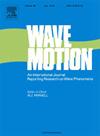基于卷积神经网络的框架检测双组分玻色-爱因斯坦凝聚体中的高阶异常波
IF 2.5
3区 物理与天体物理
Q2 ACOUSTICS
引用次数: 0
摘要
深度学习已经成功地识别了单组分玻色-爱因斯坦凝聚体中的一阶异常波。然而,在双组分耦合玻色-爱因斯坦凝聚体中异常波的预测和高阶异常波的识别仍然是未解决的挑战。本文通过将波函数的时空演化解释为图像数据,将深度卷积神经网络扩展到双组分耦合玻色-爱因斯坦凝聚体中高阶异常波的检测中。该方法成功地学习了多参数双组分耦合玻色-爱因斯坦凝聚体中异常波的复杂动力学行为。此外,我们在三维参数空间中有效地定位了一个狭窄的不规则区域,其中二阶类异常波出现。与数值方法的繁琐迭代过程相比,该方法显著减少了计算时间——考虑到时间随着控制参数的数量呈指数增长,这是一个关键优势。这项工作为探索高维参数空间中的复杂行为提供了一种可扩展的工具,在非线性光学、等离子体物理和海洋工程中具有潜在的应用前景,在这些领域,对极端波浪的快速预测至关重要。本文章由计算机程序翻译,如有差异,请以英文原文为准。
Detecting high-order rogue waves in two-component Bose–Einstein condensates via a convolutional neural network-based framework
Deep learning has successfully enabled the identification of first-order rogue waves in single-component Bose–Einstein condensates. However, the prediction of rogue waves and identification of high-order rogue waves in two-component coupled Bose–Einstein condensates remain unresolved challenges. In this paper, we extend the application of deep convolutional neural network to the detection of high-order rogue waves in two-component coupled Bose–Einstein condensates by interpreting the spatiotemporal evolution of wave functions as image data. The method successfully learns the complex dynamic behaviors of rogue waves in two-component coupled Bose–Einstein condensates governed by multiple parameters. Moreover, we efficiently locate a narrow, irregular region within the three-dimensional parameter space where second-order-like rogue waves arise. Compared with the tedious iterative processes of numerical methods, this approach significantly reduces computational time—a critical advantage given that time grows exponentially with the number of control parameters. This work provides a scalable tool for exploring complex behaviors in high-dimensional parameter spaces, with potential applications in nonlinear optics, plasma physics, and ocean engineering, where the rapid prediction of extreme waves is critical.
求助全文
通过发布文献求助,成功后即可免费获取论文全文。
去求助
来源期刊

Wave Motion
物理-力学
CiteScore
4.10
自引率
8.30%
发文量
118
审稿时长
3 months
期刊介绍:
Wave Motion is devoted to the cross fertilization of ideas, and to stimulating interaction between workers in various research areas in which wave propagation phenomena play a dominant role. The description and analysis of wave propagation phenomena provides a unifying thread connecting diverse areas of engineering and the physical sciences such as acoustics, optics, geophysics, seismology, electromagnetic theory, solid and fluid mechanics.
The journal publishes papers on analytical, numerical and experimental methods. Papers that address fundamentally new topics in wave phenomena or develop wave propagation methods for solving direct and inverse problems are of interest to the journal.
 求助内容:
求助内容: 应助结果提醒方式:
应助结果提醒方式:


